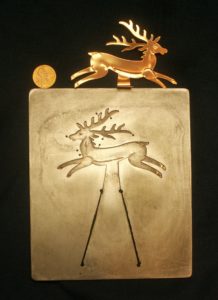This is a one-piece die that cuts and embosses in one pressing . The copper sample is 26ga. (.016″) ; the embossing wires are 24 ga. nickel silver (round) , super-easy-silver-soldered to the face of the die. When pressing, the die is placed on a solid nylon block ; specifically nylon because, a) it is
stiff and solid enough to fully support the delicate parts of the die for cutting (essential for pancake dies in general and particularly important with a design like this) , and b) nylon is soft enough under pressure (extra pressure directed to the wires once the part is cut ) to temporarily conform to the
wire designs . The copper is thin and soft enough to become embossed as it is sandwiched between the die and the nylon with about 15 tons of pressure.
The many extra holes drilled in the die are ‘cheater’ holes drilled so that I didn’t have to feed a fresh sawblade through every part I’d already sawed every time a blade broke. This die is made of 5/64″ thick heat treated tool steel ; I used size 3/0 Pike Platinum blades , the best brand for this work, but a bit brittle sometimes (made hard to cut hard metals) , and so I went through a lot of blades on this die . I used the 5/64″ steel and 3/0 blades because it allowed me to set the die plate at a lesser angle while sawing, which leaves thin, delicate areas that have more mass than when cut with larger blades at a more actue angle. Pancake dies are supposed to work, and when you set the sawing angle correctly, they are capable of cutting thin metals (26ga and thinner) quite neatly. The 5/64″ steel is thick enough to cut 16 ga. but I wouldn’t let as intricate a die as this to cut metal that thick , because of the risk of failure, and it wouldn’t emboss metal so thick, anyway.
This type of line embossing puts the wires in direct contact with what is technically the back side of the cut piece , and thin metal like 26 or 24 ga is typically used because it is thin enough so that the sheet metal is actually bending and conforming , as opposed to pressing the same wires into say, 16 ga , where such thick metal would not bend around such small diameter wires. instead, the lines would be pressed into the surface of the metal while the piece itself would remain flat . That second scenario is what happens in coining , and the thin nickel silver wire designs like those shown here are not strong enough to hold up to that for long term use.
So, normally , this embossing pushes designs up from the back, so the front of the piece ends up with more muted lines than this piece shows , because this piece is shown from what is technically the back side, the side that the wires contact directly in the press. This sharpness is what the client (Haw Creek Forge , makers of some very nice garden art in North Carolina) wanted . So the back of the piece becomes the front, and the flattening out in the second pressing , done against the same solid nylon block at a somewhat lower pressure , leaves the piece looking much like a piece that was cut flat and had lines stamped in by hand (or a part that was made by a very expensive industrial production setup ) .
sheltech
Latest posts by sheltech (see all)
- A Brief History of the RT/Pancake Die Universe - March 10, 2018
- The Timber Bay Embossed Butterfly - April 4, 2015
- Amazonite and Silver Set - August 8, 2014


{ 5 comments… read them below or add one }
making dies for people is my main gig. use sheltech@yahoo.com email please
Hi Dar
Looks real good and just enjoyed your article on die cutting angles.
Do you sell pancake dies yourself or would you be interested in doing a few for me and my wife?
Thanks James
Yowza!! Thanks.
About 8.5 degrees for the 5/64″ steel , with 3/0 blades , with heat treating in mind. I’d go a half or whole degree more if the design wasn’t complicated . With 4 thicknesses of steel I use regularly, and 5 sizes of blade, that’s 20 base angles , and when you throw in small adjustments for tighter or looser dies , the real number of possible angles at least triples . There’s a range of a couple degrees for each blade/steel combination, depending on what thickness of metal you want the die to cut, and how complex the design is .
Dar, what was the lesser angle?